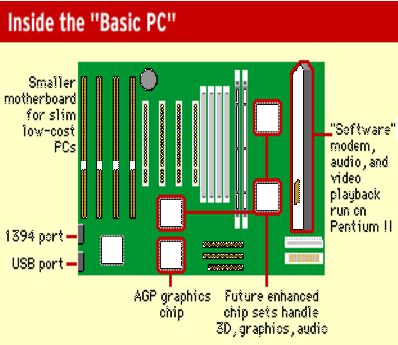
Computers in 1998...
The Microsoft and Intel's are working together to come up with a guideline standard for new PC's . The name of the standard will be called PC98 for this year and PC99 for next year and so on.
For a computer to be able to use and display the PC98 logo they must follow the standard.
There is a look at some of the design issues used for the PC98 standard.
The essential requirements of PC 98 are:
200MHz Pentium class P5 processor with MMX,
32MB ram, (64 MB recommenced for 1999)
The required system buses are PCI, USB, IEEE 1394.
Also called Firewire ACPI instead of PnP/APM.
ISA devices are not allowed (except embedded on mainboard)
but ISA slots are allowed. TV capability is also emphasized in Consumer PC
1024×768×16bit video
PC 98: Display Adaptor must have two screens of
800x600x16bpp (2MB) for page flipping, 3D
acceleration with 1.25MB texture cache or AGP,
Z-buffer. Downloadable RAMDACs for gamma
correction at 24bbp.
Device Bay is recommended for PC 98,
8X CD or 1X DVD for 98, 2X DVD for 99
Modems 33.6+ Kb/s for 98
and 56 Kb/s, V.80, V.250 for 99
In PC 98, drivers must support unattended
installation and help files for special parameters.
PCI modem will soon be available at a
similar price level to the ISA modem.
Intel is coming out with an across-the-board low-cost PC design which touches almost everything under the hood of an advanced PC. In the end, Intel aims to enhance the low-cost PC and trim fat simultaneously.
Products coming under this effort include new Pentium II processors and chipsets, a small PC circuit board called the microATX, and a shift to software of many media functions that have traditionally required special hardware.
Soft modem, soft DVD, soft audio--most of these technologies will start appearing in products this year with broad availability as a standard feature in 1999. Almost all of this specialized audio, DVD, and modem hardware can be eliminated by either running these functions on the Pentium II processor or on future, high-powered Intel chipsets which have integrated audio and 3D graphics.
At the core of these machines will be the first "Covington" Pentium II processors that come without the extra high-speed "cache" memory.

What do you think of having "The TXT" on-line? E-mail Bob Pajot ---> rdpajot@netcore.ca